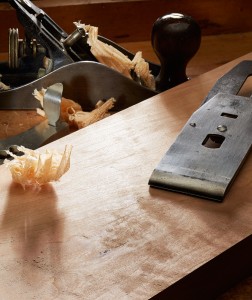We may receive a commission when you use our affiliate links. However, this does not impact our recommendations.
There was a time when nearly even adult male in the United States owned a Stanley #4 smooth plane. The one I have was passed down to me by my dad (a chemical engineer) who got it from his dad (a tool and die maker). When I was a kid, dad dragged the thing out every few years, sharpened it on a Norton oil stone and had at the edge of whatever door in the house decided to stick that summer. I played the role of door jack as he hacked away on the edge. When I got serious about woodworking I had do some work on the plane; there were paint spatters on the tote, the body was a bit rusty and the iron wasn’t in particularly good shape.
In the April issue of Popular Woodworking Magazine is one of the most valuable articles we have ever published, “Chipbreaker: Theory & Use” by Kees van der Heiden and Wilbur Pan. This article came about because in the course of online forum discussions a year or two ago, the question “why isn’t a magazine publishing an article about this?” was asked repeatedly.
The important part of this is that the technique of setting the chipbreaker extremely close to the edge of the iron enables a garden variety old plane to produce a great surface on nearly any wood. The board in the photo was planed by my old Stanley, using the stock iron and chipbreaker. I deliberately planed in the wrong direction. In the foreground you see a lot of tearout. That side of the board was planed with the chipbreaker set back about 3/32″ from the edge. On the other side (the smooth and shiny side) the chipbreaker was set as close as I could get it.
The ability to use a handplane is a skill every woodworker should have, whether they prefer machines for most tasks or are of the hand tool only persuasion. In my work, I remove chatter marks from our jointer and planer with my plane. This is faster, easier and produces better results than using a belt sander or random orbital sander. I also use it to level surfaces where one piece of wood meets another, as in panels or mortise and tenon joined frames. I don’t suffer from the notion that dressing rough lumber by hand is enjoyable, but if I needed to I could. My goal is to produce the best work I can in the shortest amount of time, and planes are an essential part of that.
I don’t have anything against the alternative solutions to controlling plane tearout, or the people who make high-end hand tools. The woodworking world is a better place with makers of fine handplanes in it. But if you’re just starting out or on a limited budget you can find an old Stanley for little money and get great results. If you get bit by the handplane bug you’ll eventually want the best you can afford in a number of iterations. In the meantime, you can discover if handplanes work for you with a cheap plane and a simple setting.
If you are a subscriber to Popular Woodworking Magazine, your April 2014 issue will be showing up soon. If you’re not a subscriber, you can fix that if you click here for the printed version or click here for the digital version. If you want to check out the issue, it will soon be available in our store.
Here are some supplies and tools we find essential in our everyday work around the shop. We may receive a commission from sales referred by our links; however, we have carefully selected these products for their usefulness and quality.










“On the other side (the smooth and shiny side) the chipbreaker was set as close as I could get it.”
What a coincidence, Bob. Several classic woodworking books by British authors give the same advice, practically verbatim, when planing difficult stock, namely, “set the chipbreaker as close as you can get it to the cutting edge.”
If this information was lost to us, it’s only because we have not kept up with our reading.
Nothing new under the sun.
Besides being useful this article is a recognition of the fact that the No.4 set the standard for generations.
Thanks, Robert! This will certainly help improve my results. Now, follow up with how close to position the frog to the throat. I’m getting good results but not excellent. Russell Pitner